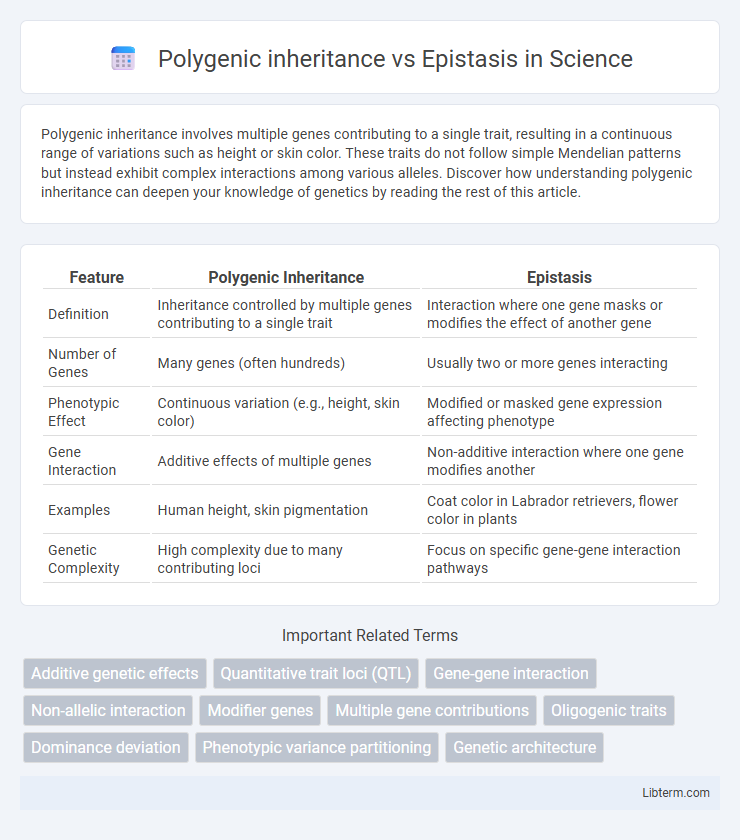Polygenic inheritance involves multiple genes contributing to a single trait, resulting in a continuous range of variations such as height or skin color. These traits do not follow simple Mendelian patterns but instead exhibit complex interactions among various alleles. Discover how understanding polygenic inheritance can deepen your knowledge of genetics by reading the rest of this article.
Table of Comparison
| Feature | Polygenic Inheritance | Epistasis |
|---|---|---|
| Definition | Inheritance controlled by multiple genes contributing to a single trait | Interaction where one gene masks or modifies the effect of another gene |
| Number of Genes | Many genes (often hundreds) | Usually two or more genes interacting |
| Phenotypic Effect | Continuous variation (e.g., height, skin color) | Modified or masked gene expression affecting phenotype |
| Gene Interaction | Additive effects of multiple genes | Non-additive interaction where one gene modifies another |
| Examples | Human height, skin pigmentation | Coat color in Labrador retrievers, flower color in plants |
| Genetic Complexity | High complexity due to many contributing loci | Focus on specific gene-gene interaction pathways |
Introduction to Polygenic Inheritance and Epistasis
Polygenic inheritance involves multiple genes contributing additively to a single trait, resulting in continuous variation such as height or skin color in humans. Epistasis occurs when one gene's expression masks or modifies the effect of another gene, leading to non-Mendelian genetic interactions that alter phenotypic outcomes. Understanding polygenic inheritance and epistasis is crucial for interpreting complex traits influenced by multiple genetic factors and their interactions.
Defining Polygenic Inheritance
Polygenic inheritance involves multiple genes collectively influencing a single trait, resulting in continuous variation such as height or skin color. Unlike epistasis, where one gene's expression masks or modifies another's effect, polygenic traits arise from the additive or interactive effects of many genes. This complex genetic architecture underlies many quantitative traits and contributes to phenotypic diversity in populations.
Understanding Epistasis
Epistasis occurs when the effect of one gene is modified by one or more other genes, deviating from the typical Mendelian inheritance patterns seen in polygenic traits where multiple genes independently contribute to a phenotype. This gene interaction can mask or alter phenotypic expression, making the genetic analysis more complex than the additive effects observed in polygenic inheritance. Epistasis reveals the hierarchical nature of gene networks and emphasizes that gene products often interact in pathways rather than acting in isolation.
Genetic Mechanisms: Polygenic Traits Explained
Polygenic inheritance involves multiple genes collectively influencing a single trait, resulting in continuous variation such as height or skin color. In contrast, epistasis occurs when one gene's expression masks or modifies the effect of another gene, affecting trait outcomes in complex genetic interactions. Polygenic traits are typically controlled by additive effects of several loci, generating a broad phenotypic spectrum rather than discrete categories.
Epistasis: How Genes Interact
Epistasis occurs when one gene's expression masks or modifies the expression of another gene, affecting phenotypic traits in complex ways. Unlike polygenic inheritance, where multiple genes independently contribute to a trait, epistatic interactions involve hierarchical gene relationships influencing outcomes such as coat color in Labrador retrievers. These gene interactions are crucial for understanding genetic pathways, disease mechanisms, and trait variability beyond additive genetic effects.
Key Differences Between Polygenic Inheritance and Epistasis
Polygenic inheritance involves multiple genes contributing additively to a single phenotypic trait, resulting in continuous variation such as human height or skin color. Epistasis occurs when the expression of one gene is modified or suppressed by one or more other genes, leading to non-Mendelian inheritance patterns and altered phenotypic ratios. Key differences include polygenic traits showing quantitative variation controlled by many genes, whereas epistasis involves gene interactions where one gene masks or modifies the effect of another, affecting single traits with qualitative variation.
Examples of Polygenic Inheritance in Nature
Human skin color, height, and eye color exemplify polygenic inheritance, where multiple genes collectively influence a single trait, resulting in continuous variation rather than discrete categories. In plants, the kernel color of wheat and the grain size in rice also demonstrate polygenic traits controlled by several gene loci. Unlike epistasis, where one gene affects the expression of another, polygenic inheritance builds phenotypic diversity through the additive effects of many genes.
Real-World Cases of Epistasis
Epistasis occurs when one gene's expression masks or modifies the effect of another gene, influencing traits like coat color in Labrador Retrievers, where the B and E genes interact to determine fur pigmentation. In polygenic inheritance, multiple genes contribute additively to a single phenotype, as seen in human height or skin color, with no single gene masking another. Real-world cases of epistasis include sickle cell anemia, where the presence of a modifier gene affects the severity of symptoms, and flower color in sweet peas, where gene interactions alter pigment production patterns.
Implications for Genetic Research and Medicine
Polygenic inheritance involves multiple genes contributing additive effects to a trait, complicating the identification of specific genetic variants linked to diseases, which challenges precision medicine approaches. Epistasis, where one gene's effect masks or modifies another gene's expression, highlights complex gene-gene interactions that can influence phenotypic outcomes and drug responses, emphasizing the need for integrative genetic models. Understanding both mechanisms enhances predictive accuracy in genomics, aids in the discovery of novel therapeutic targets, and informs personalized treatment strategies in genetic research and medicine.
Summary: Distinguishing Polygenic Inheritance from Epistasis
Polygenic inheritance involves multiple genes contributing additively to a single trait, resulting in continuous variation such as height or skin color. Epistasis occurs when the expression of one gene is affected or suppressed by one or more other genes, often leading to altered phenotypic ratios in offspring. Understanding these mechanisms is crucial for interpreting complex genetic traits, where polygenic inheritance explains quantitative traits and epistasis reveals gene interactions modifying phenotypic outcomes.
Polygenic inheritance Infographic

 libterm.com
libterm.com